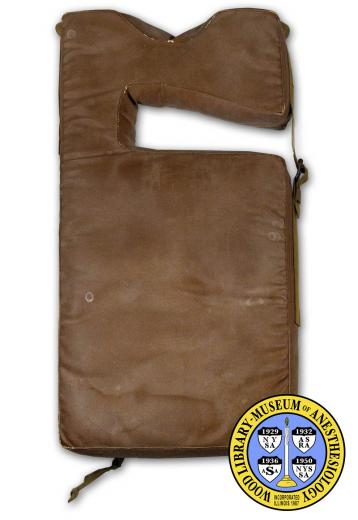Lemmon Mattress
The technique of continuous spinal anesthesia was pioneered by Dr. William T. Lemmon (1896-1974). By receiving anesthesia to only one part or region of the body, the patient has some awareness, and can respond to questions and instructions. Continuous spinal anesthesia also enables lengthy surgical procedures on the abdomen and lower limbs that cannot be done under general anesthesia, due to the inherent risks from prolonged inhalation of anesthetics.
In 1940, Dr. Lemmon described the apparatus he designed for this purpose, including a syringe, tubes, stopcocks, and this mattress. The needle stayed in place throughout the surgery. The local anesthetic is administered through the catheter, a faster and smoother method than repeated injections. The opening in the mattress prevented the needle from being unintentionally repositioned or dislodged when the patient was placed flat on his back. The straps helped to keep the an0esthetized patient in the correct position. Additional pads could be added to lengthen the mattress.
Dr. Lemmon’s work inspired a number of other physicians to test and experiment with the method, which quickly led to further significant developments, including the use of continuous drop infusions and flexible spinal catheters.
Catalog Record: Lemmon Mattress
Access Key: aiwz
Accession No.: 2011-01-20-1
Title: [Lemmon mattress for continuous spinal anesthesia / designed by William T. Lemmon.]
Author: Lemmon, William T., 1896-1974.
Corporate Author: George P. Pilling & Son Company.
Title variation: Alt Title
Title: William Lemmon’s mattress for spinal anesthesia.
Title variation: Alt Title
Title: Upper portion of a Lemmon mattress.
Title variation: Alt Title
Title: Head end of pad used in continuous spinal anesthesia.
Title variation: Alt Title
Title: Special mattress for continuous spinal anesthesia.
Publisher: Philadelphia, PA : George P. Pilling & Son, [1938-1950].
Physical Descript: 1 mattress : canvas, rubber, metals ; 13 x 91 x 47 cm.
Subject: Anesthesia, Spinal.
Subject: Anesthesia, Spinal – methods.
Subject: Anesthesia, Conduction.
Subject: Anesthesia, Regional.
Note Type: Historical
Notes: Title based on the WLM name for the object. Alternate titles based on
references to the mattress in Lemmon’s articles.
Note Type: Citation
Notes: Lemmon WT. A method for continuous spinal anesthesia: a preliminary report.
Ann Surg. 1940;111(1):141-144.
Note Type: Citation
Notes: Lemmon WT, Paschal GW. Continuous spinal anesthesia: with observations on the
first 500 cases. Pa Med J. May 1941;44:975-981.
Note Type: Citation
Notes: Lemmon WT, Paschal GW. Continuous – serial, fractional, controllable,
intermittent – spinal anesthesia: with observations on 1000 cases. Surg
Gynecol Obstet. May 1942;74:948-956.
Note Type: Citation
Notes: Lemmon WT, Paschal GW. Continuous spinal anesthesia in abdominal and thoracic
surgery. Surg Clin North Am. December 1942;(Philadelphia no.):1729-1739
Note Type: Citation
Notes: Lemmon WT, Hager HG. Continuous spinal anesthesia: observations on 2000 cases
Ann Surg. 1944;120(2):129-142.
Note Type: Physical Description
Notes: An operating table mattress covered in a rust colored, molded rubber material
or a canvas material with a coating of rubber; The color is faded and the
cover is becoming brittle with age; The cover has a metal zipper so that the
inner padding, which is covered in a non-water proof textile, may be
removed; A label with manufacturer markings is sewn into the side of the
cover: “GEORGE P. PILLING & SON CO. [new line] PHILADELPHIA, PA. U.S.A.”;
There is an opening or gap in the lumbar region, continuous from one side of
the mattress to approx. three quarters in; There are canvas straps and metal
buckles on the side of the mattress to hold the upper, or torso, portion to a
detachable lower, or leg, portion of the mattress; The WLM has only the upper
portion of the mattress.
Note Type: Reproduction
Notes: Photographed by Mr. William Lyle, July 15, 2010.
Note Type: Historical
Notes: Dr. William T. Lemmon (1896-1974), a surgeon, administered his first
continuous or ‘fractional’ spinal anesthetic on April 10, 1939 (Lemmon, 1942)
After developing and testing a practical method over approximately 200
surgical cases Lemmon published a description of it in (Lemmon, 1940). The
technique he described involved repeated boluses of procaine via a syringe
that was attached to a malleable spinal needle which remained in the
patient’s spine during the operation (Lemmon, 1940). To allow the patient to
be positioned on his back without disturbing the needle, Lemmon designed a
special surgical mattress that had an opening in the lumbar region. The
mattress pictured in his 1940 article was composed of two pieces, one for the
patient’s upper body and one for the lower body that could be detached for
surgical procedures. The piece for the upper body is the piece that has the
opening for the lumbar area. Images of the mattress in his 1941 article,
authored with George W. Paschal, show the lower portion of the mattress with
a break to accommodate knee bending, while images of the mattress in Lemmon’s
1942 articles show the lower portion of the mattress with two breaks to
accommodate knee bending for people of varying heights. This feature was
suggested to Lemmon by the anesthesiologist Dr. Morris J. Nicholson
(1910-2011). Lemmon’s work inspired a number of other physicians to test and
experiment with the method, which quickly led to further significant
developments, including the use of continuous drop infusions and flexible
spinal catheters.
Note Type: Publication
Notes: Lemmon WT. Continuous spinal anesthesia in abdominal and thoracic surgery.
Del Med J. 1947;19(6):109-115.
Note Type: Exhibition
Notes: Selected for the WLM website (noted July 15, 2010).


